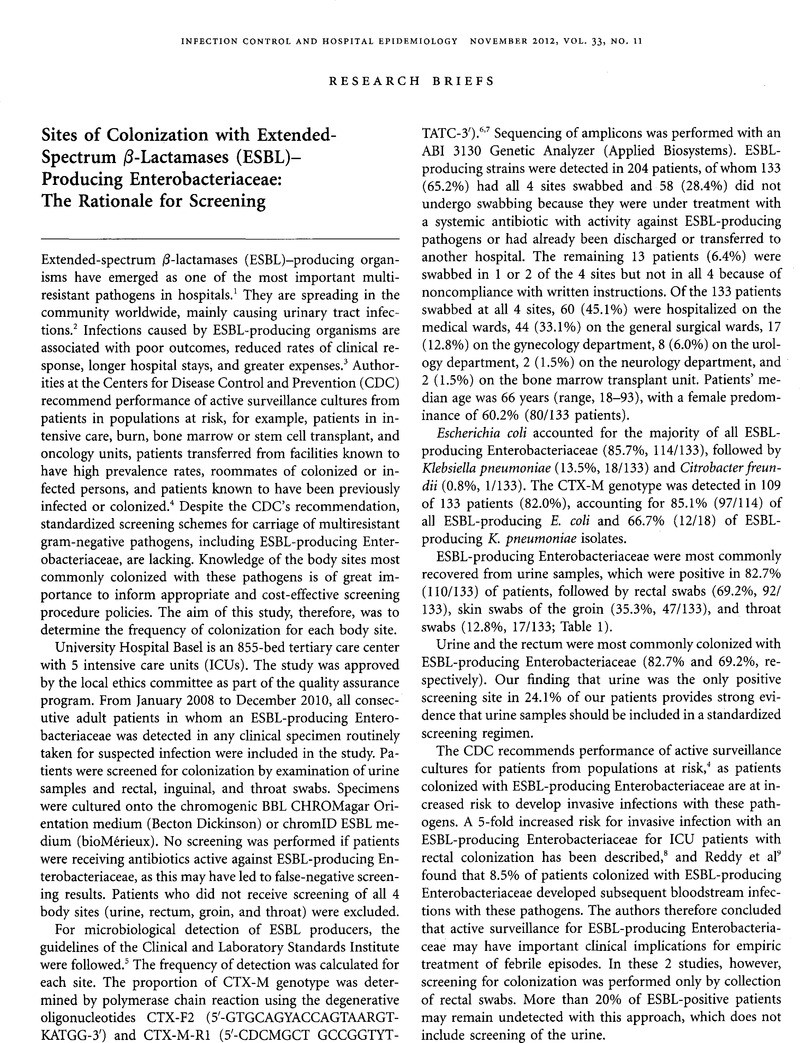Crossref Citations
This article has been cited by the following publications. This list is generated based on data provided by Crossref.
Huttner, B.
Haustein, T.
Uckay, I.
Renzi, G.
Stewardson, A.
Schaerrer, D.
Agostinho, A.
Andremont, A.
Schrenzel, J.
Pittet, D.
and
Harbarth, S.
2013.
Decolonization of intestinal carriage of extended-spectrum -lactamase-producing Enterobacteriaceae with oral colistin and neomycin: a randomized, double-blind, placebo-controlled trial.
Journal of Antimicrobial Chemotherapy,
Vehreschild, M. J. G. T.
Hamprecht, A.
Peterson, L.
Schubert, S.
Hantschel, M.
Peter, S.
Schafhausen, P.
Rohde, H.
Lilienfeld-Toal, M. v.
Bekeredjian-Ding, I.
Libam, J.
Hellmich, M.
Vehreschild, J. J.
Cornely, O. A.
and
Seifert, H.
2014.
A multicentre cohort study on colonization and infection with ESBL-producing Enterobacteriaceae in high-risk patients with haematological malignancies.
Journal of Antimicrobial Chemotherapy,
Vol. 69,
Issue. 12,
p.
3387.
Osthoff, Michael
McGuinness, Sarah L.
Wagen, Aaron Z.
and
Eisen, Damon P.
2015.
Urinary tract infections due to extended-spectrum beta-lactamase-producing Gram-negative bacteria: identification of risk factors and outcome predictors in an Australian tertiary referral hospital.
International Journal of Infectious Diseases,
Vol. 34,
Issue. ,
p.
79.
Stewardson, Andrew J.
Allegranzi, Benedetta
and
Pittet, Didier
2017.
Hand Hygiene.
p.
18.
Stadler, Tanja
Meinel, Dominik
Aguilar-Bultet, Lisandra
Huisman, Jana S
Schindler, Ruth
Egli, Adrian
Seth-Smith, Helena M B
Eichenberger, Lucas
Brodmann, Peter
Hübner, Philipp
Bagutti, Claudia
and
Tschudin-Sutter, Sarah
2018.
Transmission of ESBL-producing Enterobacteriaceae and their mobile genetic elements—identification of sources by whole genome sequencing: study protocol for an observational study in Switzerland.
BMJ Open,
Vol. 8,
Issue. 2,
p.
e021823.
van Prehn, Joffrey
Kaiser, Anna M.
van der Werff, Suzanne D.
van Mansfeld, Rosa
and
Vandenbroucke-Grauls, Christina M. J. E.
2018.
Colonization sites in carriers of ESBL-producing Gram-negative bacteria.
Antimicrobial Resistance & Infection Control,
Vol. 7,
Issue. 1,
Vock, Isabelle
and
Tschudin-Sutter, Sarah
2019.
Persisting intrahospital transmission of multidrug-resistant Klebsiella pneumoniae and challenges for infection control.
Infection Control & Hospital Epidemiology,
Vol. 40,
Issue. 8,
p.
904.
Vock, Isabelle
Aguilar-Bultet, Lisandra
Egli, Adrian
Tamma, Pranita D
and
Tschudin-Sutter, Sarah
2021.
Infections in Patients Colonized With Extended-spectrum Beta-Lactamase-Producing Enterobacterales: A Retrospective Cohort Study.
Clinical Infectious Diseases,
Vol. 72,
Issue. 8,
p.
1440.
Willems, Roel P J
van Dijk, Karin
Vehreschild, Maria J G T
Biehl, Lena M
Ket, Johannes C F
Remmelzwaal, Sharon
and
Vandenbroucke-Grauls, Christina M J E
2023.
Incidence of infection with multidrug-resistant Gram-negative bacteria and vancomycin-resistant enterococci in carriers: a systematic review and meta-regression analysis.
The Lancet Infectious Diseases,
Vol. 23,
Issue. 6,
p.
719.
Aguilar-Bultet, Lisandra
García-Martín, Ana B.
Vock, Isabelle
Maurer Pekerman, Laura
Stadler, Rahel
Schindler, Ruth
Battegay, Manuel
Stadler, Tanja
Gómez-Sanz, Elena
and
Tschudin-Sutter, Sarah
2023.
Within-host genetic diversity of extended-spectrum beta-lactamase-producing Enterobacterales in long-term colonized patients.
Nature Communications,
Vol. 14,
Issue. 1,



